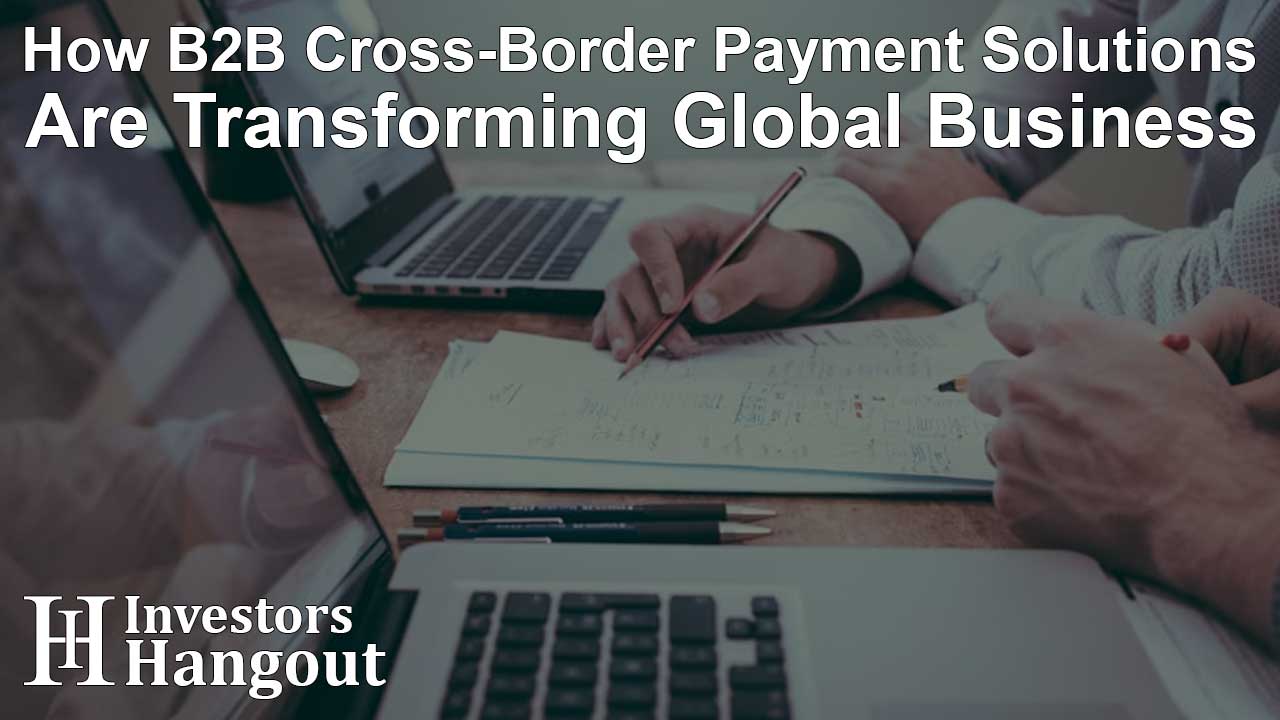How B2B Cross-Border Payment Solutions Are Transforming Global Business

The business world has undergone a dramatic transformation as companies increasingly operate across international borders. Only knowing the process of starting a business is not enough in 2025! Cross-border B2B payments, once plagued by lengthy processing times and opaque fee structures, are now experiencing a revolution driven by technological innovation and changing business expectations. The demand for faster, more transparent, and cost-effective international payment solutions has never been more critical for businesses of all sizes.
The Growing Importance of Cross-Border Payments
International B2B transactions are experiencing unprecedented growth, with global payments projected to reach approximately $290 trillion by 2030. This surge is fueled by the expansion of borderless e-commerce, increased cross-border trade, and the continued digitalization of payment systems across various industries. Small and medium enterprises now account for a significant portion of this growth, with SME B2B cross-border flows amounting to $15.8 trillion in 2023 and forecast to reach $22.3 trillion by 2030.
Traditional Challenges in International Payments
For decades, businesses have struggled with the inefficiencies of legacy payment systems when conducting international transactions. Traditional cross-border payments typically take anywhere from one to five business days to complete, depending on the countries involved, banking relationships, and compliance requirements. These delays are compounded by high transaction costs, unpredictable exchange rates, and a lack of transparency that makes cash flow management and budget projections particularly challenging for finance teams.
The complexity extends beyond just timing and costs. Different jurisdictions impose distinct regulatory requirements, compliance obligations, and banking standards, making it difficult for businesses to scale their payment operations globally. The lack of interoperability between various payment networks forces enterprises to navigate a complex web of financial institutions, each adding their own processing time and fees to every transaction.
The Fintech Revolution
Fintech companies have emerged as game-changers in the B2B cross-border payment space by leveraging modern technologies tailored to meet specific business needs. Unlike traditional banks constrained by legacy infrastructure, these innovative providers utilize proprietary payment networks, digital-first solutions, and cutting-edge technologies to deliver faster and more cost-effective services. Companies like Thunes offer comprehensive b2b cross border payment solutions that address the unique challenges faced by businesses operating in multiple markets.
These modern platforms have introduced user-friendly, digital-first tools that enhance efficiency and reduce onboarding times for businesses making international payments. By holding virtual accounts in local currencies, fintechs can significantly reduce fees compared to traditional correspondent banking networks. When a business in one country needs to pay a supplier in another, the payment is made to a local account, and the fintech debits the corresponding amount from its local account in the recipient's country, effectively bypassing expensive intermediary banks.
Real-Time Payment Infrastructure
The shift toward real-time payment systems represents one of the most significant developments in cross-border transactions. Businesses now expect fast settlement, clear cash flow visibility, and instant reconciliation across bank accounts, particularly for high-volume invoices, supplier payouts, and platform integrations. This is also a reason why start a business in Singapore! The infrastructure is quite efficient to help you in every way from payment to acquisition. This real-time infrastructure dramatically reduces settlement risk and provides finance teams with immediate visibility into cash flow and received payments.
More countries are adopting real-time payment systems that enable near-instantaneous cross-border transactions, moving away from the antiquated model where payments halt for weekends or holidays. Modern treasury platforms integrate with wallet infrastructures that maintain balances in multiple currencies and release funds instantly, bypassing traditional cut-off windows. This operational flexibility allows treasurers to optimize for cost, speed, or transparency depending on the specific transaction type and business priorities.
Blockchain and Digital Assets
Blockchain technology and stablecoins have transitioned from innovation buzzwords to vital tools in cross-border payment infrastructure. These technologies offer businesses numerous benefits, including faster settlement times, lower transaction costs, and increased transparency compared to traditional methods. Platforms utilizing blockchain can facilitate near-instantaneous, 24/7 payment processing at significantly reduced costs.
Major financial institutions are increasingly exploring blockchain-based payment solutions, with partnerships between traditional banks and fintech providers becoming more common. In fact, 62% of banks are actively seeking fintech collaborations to enhance their cross-border payment offerings. Companies' treasury departments are using blockchain rails to meet operational and regulatory liquidity requirements, moving money between national banking systems faster than traditional payment rails while using fiat-pegged stablecoins to overcome liquidity challenges.
AI and Automation
Artificial intelligence is transforming global payments by driving payment method optimization, fraud detection, dynamic routing, compliance checks, and analytics. AI-powered systems handle complex workflows across international payments, from onboarding to reconciliation, while detecting and preventing fraud in real time to improve overall payment processing security. These intelligent systems can analyze real-time exchange rates, increasing transparency and reducing foreign exchange markups that have historically eroded profit margins.
Automation reduces the need for manual data entry, approval routing, and reconciliation, freeing up valuable time and resources for finance teams. This technology enables businesses to personalize embedded finance experiences based on user behavior and risk profiles while producing deep analytics that aid in compliance and global financial planning. The result is a more efficient payment ecosystem that allows businesses to focus on strategic growth rather than administrative tasks.
Enhanced Transparency and Compliance
Regulatory scrutiny of cross-border payments continues to increase as governments and financial authorities implement strict rules to keep transactions secure and legal. Modern payment solutions address these challenges by providing end-to-end visibility, automated compliance checks, and robust reporting capabilities that help businesses navigate the complex regulatory landscape. This transparency extends to exchange rates and fee structures, with leading providers making costs clear upfront rather than hiding them in opaque pricing models.
Cloud technology advancements have made cross-border payments more secure and accessible by providing strong security measures including encryption, multifactor authentication, and continuous monitoring. These platforms can scale significantly, allowing financial institutions and payment processors to handle increasing transaction volumes without major infrastructure investments. This flexibility proves especially valuable during peak transaction periods such as holidays or other high-volume times.
The Future of Cross-Border B2B Payments
The convergence of emerging technologies, regulatory shifts, and evolving business needs is redefining global payments in ways that seemed impossible just a few years ago. Cross-border B2B payments are no longer just transactions but strategic assets that can provide competitive advantages to businesses that embrace modern solutions. The boundaries between traditional banking and fintech continue to blur, creating hybrid models that combine the scale and regulatory expertise of financial institutions with the innovation and customer-centric approach of technology companies.
Looking ahead, the payment industry will continue to address its biggest challenge: handling global payments efficiently while maintaining security and compliance. As real-time payment networks grow and connect with each other, they will likely become the standard way to make international payments. Businesses that adopt these modern payment solutions will not only improve how they handle global transactions but also position themselves ahead of competitors in an increasingly connected global marketplace.
Conclusion
The transformation of B2B cross-border payment solutions represents a fundamental shift in how businesses operate internationally. With faster processing times, reduced costs, enhanced transparency, and improved compliance capabilities, modern payment platforms are enabling companies to expand globally with confidence. As technology continues to advance and adoption increases, businesses that embrace these innovations will find themselves better equipped to navigate the complexities of international commerce and capitalize on global opportunities.
About The Author
Contact Caleb Price privately here. Or send an email with ATTN: Caleb Price as the subject to contact@investorshangout.com.
About Investors Hangout
Investors Hangout is a leading online stock forum for financial discussion and learning, offering a wide range of free tools and resources. It draws in traders of all levels, who exchange market knowledge, investigate trading tactics, and keep an eye on industry developments in real time. Featuring financial articles, stock message boards, quotes, charts, company profiles, and live news updates. Through cooperative learning and a wealth of informational resources, it helps users from novices creating their first portfolios to experts honing their techniques. Join Investors Hangout today: https://investorshangout.com/
